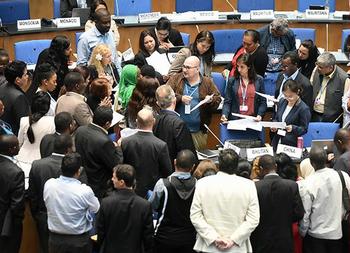World Governments Are Limiting Carbon Emissions

June 7, 2015 (ENS) – Three-quarters of the world’s annual emissions of greenhouse gases are now limited by national targets, finds a new study published by the Grantham Research Institute on Climate Change and the Environment at London School of Economics and Political Science.
The 2015 Global Climate Legislation Study, covering 98 countries plus the European Union which are together responsible for 93 per cent of global emissions, was presented to delegates in Bonn, where the latest round of United Nations climate change negotiations is taking place.
The study is sponsored by GLOBE, the Global Legislators Organisation, and the Inter-Parliamentary Union, the world organization of parliaments, established in 1889. Its results will be distributed to policy-makers around the world.
Led by Michal Nachmany and Sam Fankhauser, the study finds that 53 countries, including the 28 Member States of the European Union, have national targets that set either absolute or relative limits on annual emissions of greenhouse gases across their economies.
Nachmany said, “With three-quarters of the world’s greenhouse gas emissions now covered by national targets, we can be more confident about the credibility of the pledges that countries will make ahead of the crucial United Nations summit in Paris in December this year.”
“While collectively these pledges are unlikely to be consistent with the international goal of avoiding global warming of more than 2 centigrade degrees, the existence of national legislation and policies should provide the opportunity for countries to strengthen the ambition of their emissions cuts after the summit,” Nachmany said.
The study found that the 98 countries and the European Union together had 804 climate laws and policies at the end of 2014, compared with 426 in 2009, when a previous attempt was made in Copenhagen, Denmark, to reach an international agreement.
In 1997, when the Kyoto Protocol was agreed, these countries had just 54 climate laws and policies among them.
Professor Fankhauser said, “Every five or so years the number of climate laws and policies across the world has doubled. This growing amount of legislation provides evidence that the world’s major emitters are taking serious steps to tackle climate change in their countries. By writing their intentions into law, the world’s leaders have shown that international climate change talks do lead to national action in the vast majority of countries.”
The study shows that 75 countries plus the European Union have frameworks for limiting greenhouse gas emissions, while 64 countries have frameworks for adapting to the impacts of climate change.
Yet only 37 countries have completed a fully comprehensive national climate change risk assessment.
A total of 47 countries, including the 28 Member States of the European Union, have introduced carbon pricing through either a carbon tax or a cap-and-trade system.
Graham Stuart, a Member of the UK Parliament and Chair of GLOBE, said, “GLOBE International exists to bring parliamentarians together to address environmental challenges. This study captures the work of legislators around the world in building the legal frameworks which trigger investments that can lower emissions and drive down costs.”
Saber Chowdhury, a Member of the Bangladesh Parliament and President of the Inter-Parliamentary Union, said, “Legislators are a central element of any successful strategy for tackling climate change and they bear their own share of responsibility for its effective implementation.”
The study allows cross-country comparisons so that governments can be held to account for their responses to climate risks.
It builds on earlier editions by GLOBE and the Grantham Research Institute, and shows both the progress made and how much more needs to be done.
Collected: http://ens-newswire.com/

